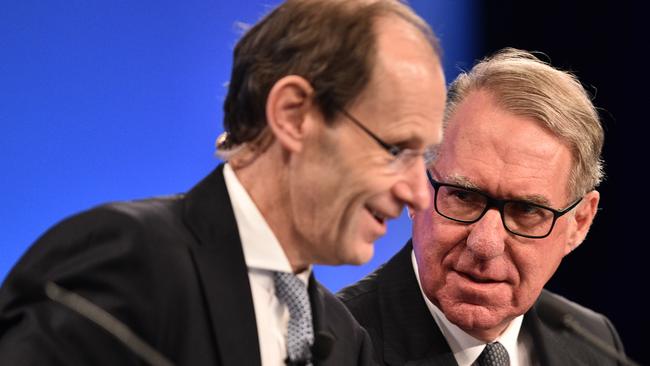Big banks plot bonus shake-up amid backlash
Major bank boards are preparing to overhaul remuneration structures next year amid a wave of shareholder anger.

Major-bank boards are preparing to overhaul remuneration structures next year, as National Australia Bank and ANZ brace for a wave of shareholder anger over lack of executive accountability for widespread industry misconduct.
On Wednesday, NAB is likely to attract a record “no” vote for its remuneration report in a range of 70-80 per cent, easily eclipsing this week’s extraordinary 64 per cent for Westpac and Telstra’s previous record for a blue-chip company of 66 per cent in 2007.
ANZ is an even-money bet for a first strike on its report, also on Wednesday.
Influential proxy adviser Ownership Matters said in its NAB report that the lack of serious penalties for risk and conduct were the result of design and implementation flaws in the bank’s new remuneration structure.
This made it “exceptionally difficult” to declare zero bonuses, even when risk and conduct fell short of board, investor, regulator and customer expectations.
Westpac chairman Lindsay Maxsted promised yesterday to reconsider the bank’s remuneration framework.
Mr Maxsted said the review would take place next year and consider feedback from investors, the final report of royal commissioner Kenneth Hayne due by February 1, and additional guidance expected from the prudential regulator APRA on industry remuneration.
“All the feedback we received was that the problem was not so much to do with frameworks but the amounts allocated (to executives),” he told The Weekend Australian.
“But given it was such a negative vote, it’s incumbent on me and the other directors to look at the long-term and short-term incentives to see if the structures should change.”
The NAB board is also expected to overhaul its pay framework, despite chairman Ken Henry unveiling a new model only in September.
Any changes will seek to strike a better balance between customer outcomes and long-term performance for shareholders.
At Commonwealth Bank, remuneration committee chairman David Higgins flagged in the annual report that one of the committee’s priorities in 2019 was to undertake a comprehensive review of the bank’s executive remuneration framework.
ANZ has committed to a similar program.
The white-hot debate over executive pay in the financial services industry has transcended many levels. However, one investor said there was a single, overriding theme.
“All we want to know is the true level of pay that’s ‘at risk’,” he said.
“If all of the bonus pool is not at risk, then part of the pool becomes fixed pay. The banks should just say it like it is, instead of trying to make it so opaque that no one understands.”
While OM has recommended a “no” vote for the NAB and ANZ remuneration reports, the outcome for ANZ was yesterday hanging in the balance.
The bank has pitched strongly to investors that it has emerged the least wounded of the big four from the royal commission hearings, and learnt a valuable lesson from a 2015 protest vote over then-chief executive Mike Smith’s inflated package. Since then, salaries have been reset with each new appointment to the executive team. Statutory remuneration of chief executive Shayne Elliott and disclosed executives has fallen by 40 per cent.
An October 16 email exchange between Mr Elliott and ANZ chairman David Gonski, in which the chief executive asked for a pay cut, would have helped the cause when it was picked up in the royal commission’s dragnet.
Mr Elliott noted that ANZ would be lowering the 2018 variable pay of senior executives to an average of 77 per cent of their targets, and it was important that his own remuneration was no higher.
“It’s about unity, accountability, and frankly credibility — externally, but even more importantly, internally,” Mr Elliott said.
One investor complained yesterday that the manoevrings and behind-the-scenes lobbying completely missed the point.
“ANZ might have had a better royal commission than the other major banks, but no one is addressing the terrible impact of all this on staff morale,” he said.
“If the executives at the top are not being seriously penalised, it just makes the people downstairs laugh — they think the executives are pulling the wool over the directors’ eyes.”
OM described the Henry remuneration blueprint at NAB as a “combined incentive plan”, where executives no longer received long-term incentives measured against transparent targets over multiple years. Instead, executives received much larger annual incentives, including cash bonuses up to 60 per cent higher than previous arrangements, with 60 per cent awarded as deferred shares.
The changes, according to OM, reduced executive pay for exceptional performance but lifted pay for mediocre outcomes.



To join the conversation, please log in. Don't have an account? Register
Join the conversation, you are commenting as Logout